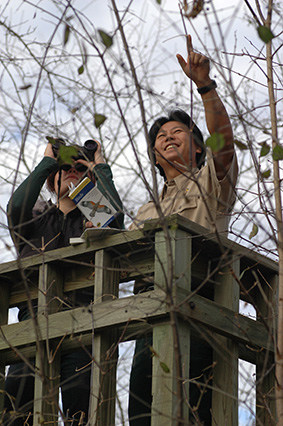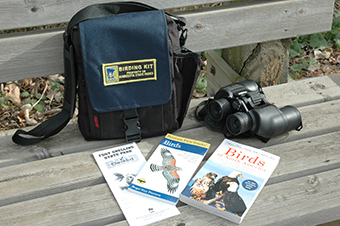When Alex Watson walks through a state park, he can tell what’s going on over the next hill because of audio cues he hears from birds.
“The calls are packed with meaning,” he said. The identification from bird calls and songs came with practice and time starting in 2001. Back then Watson noticed the birds at his family’s bird feeder and then picked up his dad’s bird watching guide.
The moment arrived. Watson, a DNR regional naturalist out of New Ulm, said that the book and bird feeding activity sparked an awareness that our planet is shared with a huge population of diverse creatures. In that moment, a lifelong interest took root.
Hundreds of bird species nest in or pass through Minnesota state parks. Free “Birding Kits” can be borrowed at many parks and include a bird guide, checklist and binoculars. Also, many park naturalists conduct bird-related programs like “Birding for Beginners” on May 4 at Fort Snelling State Park, “Spring Bird Migration” on May 4 at Mille Lacs Kathio State Park, or “Kids, Birds and Binoculars” on May 11 at Interstate State Park. Most programs are free but some require advance registration, so check the park website.
Over the years and after becoming familiar with hundreds of birds, Watson said he’s learned about migration, population changes, adaption to environmental changes, and the significance of calls within the same species. All beginners need to start this fascinating pastime is a set of eyes and the desire to learn. Park websites offer a bird check list at many parks, so you have a heads up on which species are common, uncommon, or rarely seen.
At Afton State Park near Hastings, for example, ring-billed gulls, the American kestrels, warbling vireos and northern rough-winged swallows are common.
When you’re new to birding, Watson suggests small goals at first, like learning the sight and sound of five new birds in a summer. Most people already know a robin from a hawk from a crow, but Minnesota is home to 246 nesting bird species. Add the number of birds that simply pass through the state, and the total rises to 317.
Bird guidebooks also serve beginning birders well, and the state park Birding Kits offer a bird guide. Watson recommends the Peterson Field Guide to Birds, but added that the best bird book is the one tailored to your interests. The Peterson guides give detailed accounts of the parts of the bird from crown to tail feathers, wing details, field marks and more.
Another tool? A bird feeder or bird bath. Both will bring birds to your property where you can learn to identify them by sight and sound. You can find a good recording of bird calls on the Audubon Guide to North American Birds website (www.audubon.org/field-guide/bird) Look up “common loon,” for example, for examples of loon flight calls, wails, yodels, hoots and duets. Then find your way to a state park for a look. Birders feel a special satisfaction when they finally locate a target species, Watson said. Sometimes travel is involved after research, then the search for the bird based on a knowledge base, then hearing or seeing the bird.
“The experience brings closure and it is a good feeling,” Watson said. “It’s like winning the lottery. You get a happy feeling of accomplishment, as with any hobby. You see what you’ve never seen.”
Birds still deliver the “wow” factor to Watson, and he need not travel far at all to reach it. In February he heard a pair of gray horned owls outside his bedroom window late at night. They hooted in a courtship exchange on a windless winter night under a full moon.
“I never saw the birds, and knew that somewhere out there was a male calling a female who responded. They were getting ready to build a nest and lay eggs and raise their young. Bird behavior is so varied and often so spectacular that it pulls you away from your usual grind. Birds can fill you with wonder and wow moments on a weekly basis.”
For a list of state parks with bird checklists, go to mndnr.gov/parkfinder. To see which parks have Birding Kits, go to https://www.dnr.state.mn.us/state_parks/loaner.html. See the “Birds of Minnesota” list from the Minnesota DNR at https://www.dnr.state.mn.us/birds/index.html. For a list of bird-related events at Minnesota state parks, go to https://www.dnr.state.mn.us/state_parks/birding.html. Most bird programs are free, but registration may be required. Call the park before you go. A daily vehicle pass to a Minnesota state park is $7, or $35 for an annual pass, which gives year-round access to all of Minnesota’s 66 state parks.
























